Strategic Assessment of the Environmental Impact of Ski Resorts as Part of the Polish Energy Policy Project
Abstract
1. Introduction
- identification of key aspects related to ski infrastructure,
- assessment of the impact of ski resorts, renewable energy and conventional energy on the natural environment,
- analysis of development barriers of ski resorts along with the expectations of their users,
- conducting a field study to analyze the costs of traditional energy in the winter tourism sector,
- identification of the limitations of the renewable energy sector in Poland,
- analysis of the possibilities of implementing green energy in the area of ski resorts,
- SWOT analysis of the renewable energy sector,
- developing a profitable plan to introduce solar energy into the energy structure of ski resorts.
2. Literature Review of the Problem
2.1. The Essence of the Research Problem
2.2. Literature Review of the Analyzed Problem
2.3. Barriers to the Development of Renewable Energy in Poland in Ski Resorts
3. Materials and Methods
3.1. Cost Analysis of Traditional Energy Sources
- critical analysis of Polish and foreign literature on management and quality sciences and other materials constituting sources of secondary information,
- direct and indirect observation and free and focused interviews,
- collecting data from primary sources as part of control and secondary visits,
- analysis of statistical data from primary sources (derived from collected empirical data) and secondary sources,
- logical analysis when creating models and analyses of the results obtained during research,
- synthesis enabling combining the components isolated by analysis into a whole,
- mathematical and statistical analysis, enabling qualitative and quantitative presentation of the results of primary and secondary research,
- scientific reasoning combined with the processes of induction, deduction and modeling, used in the interpretation and synthesis of research results and in the creation of models.
3.2. Costs and Benefits of Introducing Green Energy
3.3. Project Profitability Index
- NPV < 0—a given project should be rejected, generating losses,
- NPV = 0—meeting the minimum efficiency requirement, the investment will not generate either losses or income,
- NPV > 0—you can implement your plan and generate profits.
- IRR > cost of obtaining capital—project profitability,
- IRR < cost of obtaining capital—lack of profitability.
4. Results and Discussion
4.1. Cost Analysis of Traditional Energy Sources
4.2. Costs and Benefits of Introducing Green Energy
4.3. Project Profitability Index
5. Conclusions and Discussion
- Renewable energy sources are a basic element of the energy transformation in Poland and the EU; they are a key element in the transformation of the energy structure of countries and eliminate negative environmental effects, as is the case in the energy sector based on fossil fuels. Investment in unconventional energy can reduce the negative impact of various sectors, including ski resorts, on the environment.
- By illustrating examples of the use of green energy on ski slopes in different parts of the world, solar and wind energy can be distinguished as independent energy sources suitable for implementation by ski resorts. Energy obtained from biomass power plants is also an environmentally neutral solution and constitutes an alternative source of power for the infrastructure.
- The barriers hindering the development of both renewable energy sources and the ski resorts themselves are mainly related to legal and social obstacles. They result from the presence of nature protection areas, incorrect construction of legal acts, and bureaucracy problems related to the lack of knowledge about the specificity of renewable energy and EIA. The social factor is related to protests, which result largely from communication problems. Reducing the severity of these barriers or eliminating them completely is a key aspect of change in Poland’s energy mix and the development of the winter sports sector. Ski areas may be another way to increase the share of non-conventional energy in the tourism sector.
- The cost structure of traditional energy sources used in the audited entity was analyzed. The possibility of investing in renewable energy technologies was indicated by presenting the share of electricity costs in the overall share of types of energy carriers used by ski slopes. It is at the level of 74.72–83.52%, depending on the year, which suggests the possibility of reducing costs and increasing efficiency through investments in unconventional energy.
- The benefits of introducing green energy were indicated through a SWOT analysis of the Polish coal sector, which is the main energy carrier in the country, and renewable energy technologies. The significant share of mining raw materials in the energy structure of EU member states is inconsistent with the institutions achieving climate neutrality by 2050. Moreover, the exploitation of remaining deposits is in many cases unprofitable, the location of the deposits affects the costs of the project, which in many cases exceeds its profitability. Green energy is environmentally friendly, is accepted by the EU and is self-sufficient and depends only on the country’s weather conditions. It limits the emission of compounds such as benzo(a)pyrene, carbon oxides, sulfur and nitrogen oxides and PM10 and PM2.5 dust.
- The profitability of the project in the form of a photovoltaic installation with a capacity of 7875 kWp was indicated, taking into account the average lifespan of the system, inverter replacement, nominal annual energy yield, investment and operating costs along with their change in value over time. The payback period for the invested capital is 10 years and 10 months. The positive value of NPV and IRR proves the possibility of implementing the assumed plan and the profitability of the project related to its generation of profits. This analysis confirms the profitability of implementing unconventional energy from the winter sports industry.
- maximum energy efficiency: renovation of buildings and development of e-mobility, as well as greater emphasis on walking and cycling,
- decarbonization of buildings: replacing oil heating systems and using climate-friendly building materials,
- solar architecture: installation of photovoltaic panels on roofs and facades, as well as the creation of buildings with a positive energy balance,
- electrification of mobility: the use of battery vehicles and hydrogen and expansion of charging infrastructure,
- large-scale power plants: obtaining all energy demand from photovoltaic and hydroelectric power plants and wind farms,
- energy storage: use of storage lakes, hydrogen and batteries.
Author Contributions
Funding
Data Availability Statement
Conflicts of Interest
Abbreviations
| OZE | renewable energy sources |
| UE | European Union |
| MW | megawatt |
| GW | Gigawatt |
| kW | Kilowatt |
| TW | Terawatt |
| TWh | terawatt hour |
| OTEC | Ocean Thermal Energy Conversion |
| GWh | gigawatt hour |
| MWh | megawatt hour |
| CO2 | carbon dioxide |
| BP | British Petroleum Statistical Review of World Energy |
| EJ | Exajoule |
| Mtoe | mega tonne of oil equivalent |
| PKB | Gross Domestic Product |
| KPEiK | National Energy and Climate Plan |
| KE | European Commission |
| OOŚ | environmental impact assessment |
| NPV | Net Present Value |
| IRR | Internal Rate of Return |
| µm | micrometer |
| kWp | kilo watt peak |
References
- Ustawa z Dnia 17 Sierpnia 2023 r. o Zmianie Ustawy o Odnawialnych Źródłach Energii Oraz Niektórych Innych Ustaw. Dziennik Ustaw. Poz. 1762. 2023. Available online: https://isap.sejm.gov.pl/isap.nsf/DocDetails.xsp?id=WDU20230001762 (accessed on 5 January 2024).
- Dyrektywa Parlamentu Europejskiego i Rady 2009/28/WE z Dnia 23 Kwietnia 2009 r. w Sprawie Promowania Stosowania Energii ze Źródeł Odnawialnych Zmieniająca i w Następstwie Uchylająca Dyrektywy 2001/77/WE oraz 2003/30/WE. Available online: https://www.lubelskie.pl/file/2017/02/Dyrektywa-w-sprawie-promowania-OZE..pdf (accessed on 5 January 2024).
- Ćwirko, M.; Piotrowicz, B. Analiza Systemu OZE i Sposobu Jego Posadowienia na Terenie Sośniej Góry w Mikołowie, Lipiec 2014. Available online: www.researchgate.net/publication/289157789_Analiza_systemu_OZE_i_sposobu_jego_posadowienia_na_terenie_Soniej_Gory_w_Mikolowie (accessed on 10 November 2023).
- Niekurzak, M.; Brelik, A.; Lewicki, W. Economic potential of recovery and recycling of silicone photovoltaics cells and non-ferrous metals as part of the transition towards a circular economy. Econ. Environ. 2023, 86, 202–224. [Google Scholar] [CrossRef]
- Columbus Elite S.A. Zielona Energia—Co to Znaczy? 2022. Available online: https://columbuselite.pl/blog/2022/06/10/zielona-energia-co-to-znaczy/ (accessed on 10 December 2023).
- Rozporządzenie Delegowane Komisji (UE) 2021/2139 z Dnia 4 Czerwca 2021 r. Uzupełniające Rozporządzenie Parlamentu Europejskiego i Rady (UE) 2020/852 poprzez Ustanowienie Technicznych Kryteriów Kwalifikacji Służących Określeniu Warunków, na Jakich Dana Działalność Gospodarcza Kwalifikuje się jako Wnosząca Istotny Wkład w Łagodzenie Zmian Klimatu lub w Adaptację do Zmian Klimatu, a także Określeniu, czy ta Działalność Gospodarcza nie Wyrządza Poważnych Szkód Względem Żadnego z Pozostałych Celów Środowiskowych (Dz.U.UE.L.2021.442.1). Available online: https://eur-lex.europa.eu/legal-content/PL/TXT/?uri=CELEX%3A32021R2139 (accessed on 10 December 2023).
- Murray, R.; Holbert, K.E. Nuclear Energy: An Introduction to the Concepts, Systems, and Applications of Nuclear Processes; Butterworth-Heinemann: Oxford, UK, 2014. [Google Scholar]
- Da Mata, J.; Mesquita, A. Comparison of the Performance, Advantages and Disadvantages of Nuclear Power Generation Compared to Other Clean Sources of Electricity, Associação Brasileira de Energia Nuclear. 2017. Available online: https://inis.iaea.org/collection/NCLCollectionStore/_Public/49/009/49009723.pdf (accessed on 10 December 2023).
- Klugmann-Radziemska, E.; Kuczyńska-Łażewska, A. Energetyka i ochrona środowiska. Generowanie i magazynowanie energii. Odpady energetyczne. In Analiza Cyklu Życia; Wydawnictwo Naukowe PWN: Warszawa, Poland, 2023. [Google Scholar]
- Niekurzak, M.; Mikulik, J. Modeling of Energy Consumption and Reduction of Pollutant Emissions in a Walking Beam Furnace Using the Expert Method—Case Study. Energies 2021, 14, 8099. [Google Scholar] [CrossRef]
- Guzik, W.; Jędral, P. Odnawialne Źródła Energii w Logistyce; CeDeWu: Warszawa, Poland, 2022. [Google Scholar]
- Moc Zainstalowana OZE Przekroczyła 25 Gigawatów. 2023. Available online: www.rynekelektryczny.pl/moc-zainstalowana-oze-w-polsce/ (accessed on 10 November 2023).
- Całus, D.; Popławski, T. Możliwości i Horyzonty Ekoinnowacyjności; Zielona Energia, Instytutu Naukowo-Wydawniczego Spatium: Częstochowa, Poland, 2018. [Google Scholar]
- Sulewski, P.; Gradziuk, P. Podręcznik OZE. Ekonomia, Technika, Prawo, Samorząd, Społeczeństwo; Fundacja FAPA: Warszawa, Poland, 2022. [Google Scholar]
- Elektrownie Wiatrowe—Wietrzność w Polsce. Available online: https://tiny.pl/c8z2p (accessed on 10 November 2023).
- Łopuszyński, M. Logistyka budowy elektrowni wiatrowych. Logistyka 2015, 6, 728–735. [Google Scholar]
- Gielnik, A.; Rosicki, R. Bezpieczeństwo Energetyczne—Surowce Kopalne vs Alternatywne Źródła Energii; Wydawnictwo Wyższej Szkoły Bezpieczeństwa: Poznań, Poland, 2013. [Google Scholar]
- Niekurzak, M. Determining the Unit Values of the Allocation of Greenhouse Gas Emissions for the Production of Biofuels in the Life Cycle. Energies 2021, 14, 8394. [Google Scholar] [CrossRef]
- Mirek, P.; Wichliński, M. Odnawialne Źródła Energii; Wydawnictwo Politechniki Częstochowskiej: Częstochowa, Poland, 2021. [Google Scholar]
- Jakubowski, D. Energia Geotermalna—Wykorzystanie, Działanie, Wady i Zalety. 2023. Available online: www.ecovibes.pl/energia/energia-geotermalna-wykorzystanie-dzialanie-wady-i-zalety/ (accessed on 10 November 2023).
- Niekurzak, M.; Lewicki, W.; Brelik, A. The Challenges for Social and Economic Policy Related to the Energy Transformation—Analysis of Profitability and Minimizing the Risk of Deciding to Invest in a Home Micro-Installation. Eur. Res. Stud. J. 2022, XXV, 144–159. [Google Scholar] [CrossRef]
- Wróblewski, P.; Niekurzak, M. Assessment of the possibility of using various types of renewable energy sources installations in single-family buildings as part of saving final energy consumption in Polish conditions. Energies 2022, 15, 1329. [Google Scholar] [CrossRef]
- Szczególnie Przyjazne dla Klimatu Tereny Narciarskie w Europie. 2023. Available online: www.snowtrex.pl/magazyn/zrownowazony-rozwoj/osrodki-narciarskie-przyjazne-dla-klimatu/ (accessed on 10 November 2023).
- When La Plagne Puts Its Green Hat on. 2020. Available online: https://en.la-plagne.com/le-mag/when-la-plagne-puts-its-green-hat-on (accessed on 10 November 2023).
- Wolf Creek Ski Area the Most Snow in Colorado, Stewardship and Sustainability. Available online: https://wolfcreekski.com/stewardship-sustainability/ (accessed on 10 November 2023).
- Kurtyka, M.; Młynarski, T. Energy Policy Transition—The Perspective of Different States, Ignacy Lukasiewicz; Energy Policy Institute: Rzeszów, Poland, 2017. [Google Scholar]
- Młynarski, T. Unia Europejska w procesie transformacji energetycznej. Krak. Stud. Międzynarodowe 2019, 16, 31–44. [Google Scholar]
- Kucharska, A. Transformacja Energetyczna. Wyzwania dla Polski wobec doświadczeń krajów Europy Zachodniej; Wydawnictwo Naukowe PWN: Warszawa, Poland, 2021. [Google Scholar]
- Niekurzak, M.; Lewicki, W.; Drożdż, W.; Miązek, P. Measures for Assessing the Effectiveness of Investments for Electricity and Heat Generation from the Hybrid Cooperation of a Photovoltaic Installation with a Heat Pump on the Example of a Household. Energies 2022, 15, 6089. [Google Scholar] [CrossRef]
- Primary Energy Production. Eurostat. 2023. Available online: www.ec.europa.eu/eurostat/statistics-explained/index.php?title=Energy_statistics_-_an_overview#Primary_energy_production (accessed on 15 November 2023).
- Wąsiński, M. Polityka energetyczna i klimatyczna Polski. In Rocznik Polskiej Polityki Zagranicznej; PISM Polski Instytut Spraw Międzynarodowych: Warsaw, Poland, 2016; pp. 195–209. [Google Scholar]
- Krajowy Ośrodek Bilansowania i Zarządzania Emisjami. Raport Dotyczący Krajowej Emisji Gazów Cieplarnianych w Okresie 2021–2030. 2023. Available online: www.kobize.pl/pl/article/okres-2021-2030/id/1476/okres-2021-2030 (accessed on 15 November 2023).
- Krajowy Plan na Rzecz Energii i Klimatu na Lata 2021–2030; Założenia i Cele Oraz Polityka i Działania; Ministerstwo Aktywów Państwowych: Warsaw, Poland, 2019.
- Gawlikowska-Fyk, A.; Borkowski, M. Jak Polska Może Osiągnąć Zwiększone Cele Redukcji Emisji Gazów Cieplarnianych do 2030 Roku, Forum Energii. 2020. Available online: www.forum-energii.eu/download/pobierz/jak-polska-moze-osiagnac-zwiekszone-cele-redukcyjne-emisji-ghg-do-2030-roku (accessed on 15 November 2023).
- Mirowski, T. Wybrane problemy związane z wykorzystaniem odnawialnych źródeł energii w Polsce. Zesz. Nauk. Inst. Gospod. Surowcami Miner. I Energią Pol. Akad. Nauk 2017, 98, 5–14. [Google Scholar]
- Wasiuta, A.; Kierończyk, P. Wybrane Problemy Administracji Publicznej. Prawo—Zarządzanie—Polityka; Wydawnictwo Gdańskiej Szkoły Wyższej: Gdańsk, Poland, 2015. [Google Scholar]
- Popczyk, J.; Kurtyka, M. Wizje Nowej Energetyki; Kopeć, S., Ed.; Akademia Górniczo-Hutnicza: Kraków, Poland, 2022. [Google Scholar]
- Krzesiwo, K.; Ziółkowska-Weiss, K. Atrakcyjność wybranych państw Europy Środkowej pod kątem uprawiania sportów zimowych i pieszej turystyki górskiej. Turyzm 2018, 28, 35–41. [Google Scholar] [CrossRef][Green Version]
- Rozporządzenie Rady Ministrów z Dnia 9 Listopada 2010 r. w Sprawie Przedsięwzięć Mogących Znacząco Oddziaływać na Środowisko. Dziennik Ustaw, nr 213, poz. 1397. 2010. Available online: https://isap.sejm.gov.pl/isap.nsf/DocDetails.xsp?id=wdu20102131397 (accessed on 10 November 2023).
- Dorocki, S.; Raźniak, P. Rozwój infrastruktury narciarskiej w Polsce i na terenie Podhala w świetle badań ankietowych. Pr. Kom. Geogr. Przemysłu Pol. Tow. Geogr. 2014, 28, 59–77. [Google Scholar]
- Krzesiwo, K. Rozwój turystyki narciarskiej w świetle idei zrównoważonego rozwoju—Stan badań. Pr. Geogr. 2015, 141, 117–140. [Google Scholar]
- Adach, O. Determinacja aktywności narciarskiej mieszkańców wybranych miast Polski. Tur. Rekreac. 2013, 10, 163–169. [Google Scholar]
- Dorocki, S. Rozwój stacji narciarskich jako lokalnych biegunów wzrostu gospodarczego. Przykład województwa małopolskiego. Przedsiębiorczość—Eduk. 2022, 18, 98–118. [Google Scholar] [CrossRef]
- Okrasiński, K.; Mikusek, R. Poradnik Ochrony Ekosystemów Górskich. Oddziaływanie Ośrodków Narciarskich na Środowisko; Stowarzyszenie Pracownia na rzecz Wszystkich Istot: Bystra, Poland, 2016. [Google Scholar]
- Gołąb, A.; Piątek, D. Warunki występowania erozji w obszarze stacji narciarskich w Karpatach Polskich. Landf. Anal. 2022, 41, 17–31. [Google Scholar]
- Kicińska, A. Oddziaływanie narciarstwa zjazdowego na środowisko przyrodnicze Beskidu Sądeckiego. Folia Tur. 2010, 22, 119–132. [Google Scholar]
- Stacje Narciarskie wchodzące w Skład Tatry Super Ski. Available online: https://bialkatatrzanska.pl/karnet-tatryski (accessed on 12 December 2023).
- Główny Urząd Statystyczny. OS-3 Sprawozdanie o Gospodarowaniu Wodą, Ściekach i Ładunkach zanieczyszczeń dla Podmiotu Szczyrkowski Ośrodek Narciarski S.A. za Okres Sprawozdawczy 2019–2022. Available online: http://form.stat.gov.pl/formularze/2022/passive/OS-3.pdf (accessed on 12 December 2023).
- Krajowa Baza o Emisjach Gazów Cieplarnianych i Innych Substancji, Sprawozdanie z Eksploatacji Urządzeń Stanowiące Część Raportu dla Podmiotu Szczyrkowski Ośrodek Narciarski S.A. za Okres Sprawozdawczy 2019–2022. Available online: https://krajowabaza.kobize.pl/ (accessed on 12 December 2023).
- Dyjak, P. Analiza konkurencyjności węgla w polskim sektorze energetycznym w odniesieniu do dyrektyw Unii Europejskiej do 2050 roku. Ekon. XXI Wieku 2018, 18, 48–61. [Google Scholar] [CrossRef]
- Szałata, Ł.; Siedlecki, A. Instalacje fotowoltaiczne jako przykład uzasadnionej ekonomicznie działalności prosumenckiej. Ekon. Sr. 2016, 57, 190–205. [Google Scholar]
- Czerniejewski, B.; Heller, K. Analiza SWOT i TOWS wybranych aspektów rozwoju energetyki rozproszonej w Polsce. Energetyka Rozproszona 2022, 7, 7–18. [Google Scholar] [CrossRef]
- Graczyk, A. Konsekwencje Zdrowotne Niskiej Emisji. Available online: https://misja-emisja.pl/knowledgebase/konsekwencje-zdrowotne-niskiej-emisji/ (accessed on 17 December 2023).
- Airly, Monitoring Jakości Powietrza w Polsce i Europie, Pył zawieszony: Czym Jest PM10, a Czym PM2.5? Aerozole Atmosferyczne. Available online: https://airly.org/pl/pyl-zawieszony-czym-jest-pm10-a-czym-pm2-5-aerozole-atmosferyczne/ (accessed on 17 December 2023).
- Marszałek, M. Listopad 2019, Co to Jest Smog? Jak Zanieczyszczenie Powietrza Wpływa na Zdrowie? Normy dla PM10 i PM2,5. Available online: https://apteline.pl/artykuly/co-to-jest-smog-jak-zanieczyszczenie-powietrza-wplywa-na-zdrowie-normy-dla-pm10-i-pm25 (accessed on 17 December 2023).
- Krajl, J. Maj 2023, Panele Fotowoltaiczne—Cena. Ile Kosztuje Fotowoltaika w 2023 Roku? Available online: https://www.oferteo.pl/artykuly/fotowoltaika-ceny (accessed on 19 December 2023).
- Kalkulator Opłacalności Instalacji Fotowoltaicznej. Available online: https://panelefotowoltaiczne.pl/Kalkulator/Oplacalnosc (accessed on 19 December 2023).
- Korzeniowski, P. Sierpień 2021, Wjechałem na Szczyt 120-Metrowej Turbiny. Jak Działa Farma Wiatrowa w Skoczykłodach. Available online: https://noizz.pl/ekologia/jak-dziala-farma-wiatrowa-wjechalem-na-szczyt-120-metrowej-turbiny/hjszxs3 (accessed on 19 December 2023).
- Gallo, A. Harvard Business Review, A Refresher on Net Present Value. 2014. Available online: http://www.cogencygroup.ca/uploads/5/4/8/7/54873895/harvard_business_review-a_refresher_on_net_present_value_november_19_2014.pdf (accessed on 19 December 2023).
- Coban, H.H.; Lewicki, W. Flexibility in power systems of integrating variable renewable energy sources. J. Adv. Res. Nat. Appl. Sci. 2023, 9, 190–204. [Google Scholar] [CrossRef]
- Niekurzak, M. The Potential of Using Renewable Energy Sources in Poland Taking into Account the Economic and Ecological Conditions. Energies 2021, 14, 7525. [Google Scholar] [CrossRef]
- Mikulik, J.; Niekurzak, M. Impact of a Photovoltaic Installation on Economic Efficiency on the Example of a Company with High Energy Consumption. Zesz. Nauk. Politech. Śląskiej 2023, 169, 521–540. [Google Scholar] [CrossRef]
- Niekurzak, M.; Lewicki, W.; Coban, H.H.; Brelik, A. Conceptual Design of a Semi-Automatic Process Line for Recycling Photovoltaic Panels as a Way to Ecological Sustainable Production. Sustainability 2023, 15, 2822. [Google Scholar] [CrossRef]
- Pan, S.Y.; Gao, M.; Kim, H.; Shah, K.J.; Pei, S.L.; Chiang, P.C. Advances and challenges in sustainable tourism toward a green economy. Sci. Total Environ. 2018, 635, 452–469. [Google Scholar] [CrossRef]
- Riojas-Díaz, K.; Jaramillo-Romero, R.; Calderón-Vargas, F.; Asmat-Campos, D. Sustainable Tourism and Renewable Energy’s Potential: A Local Development Proposal for the La Florida Community, Huaral, Peru. Economies 2022, 10, 47. [Google Scholar] [CrossRef]
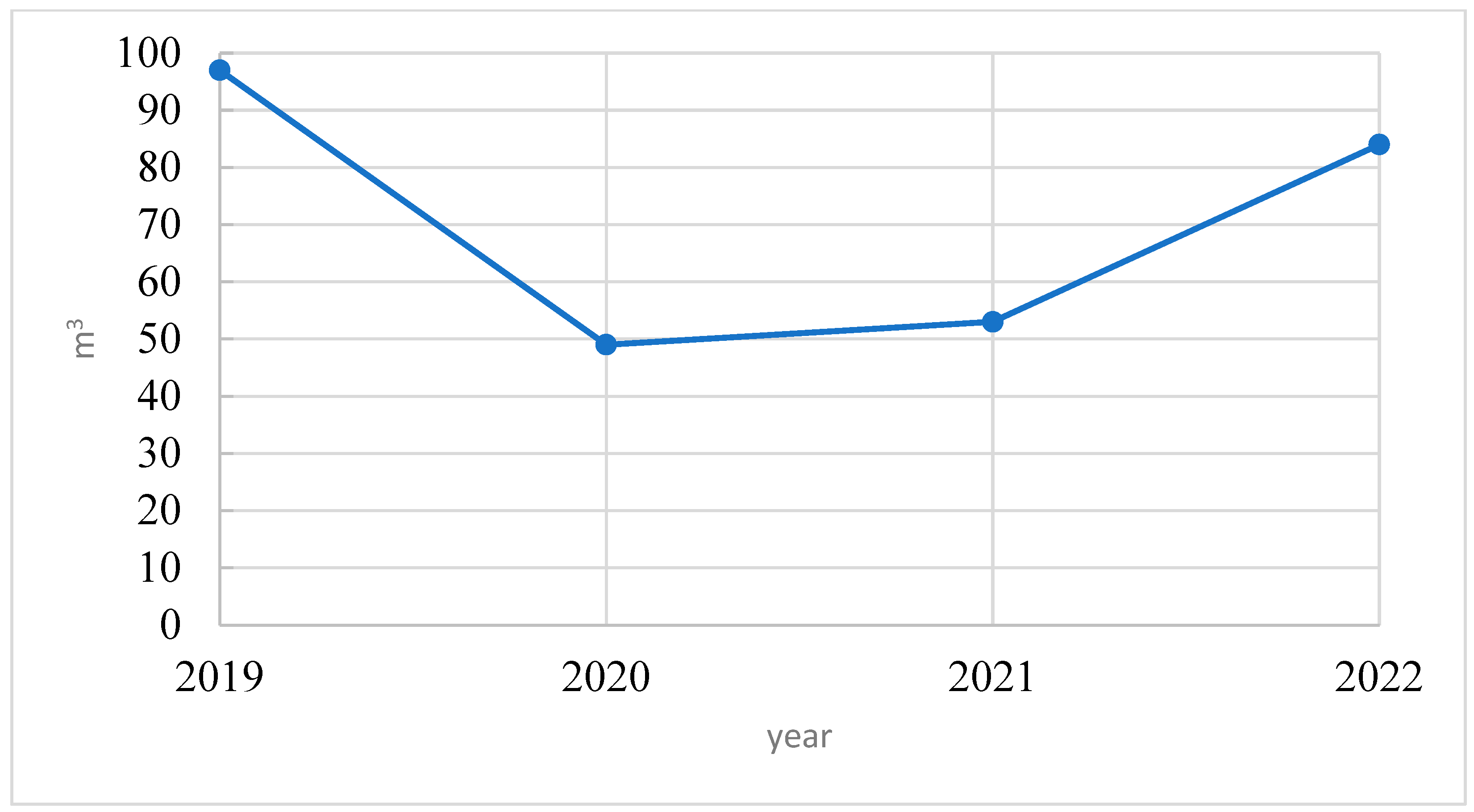
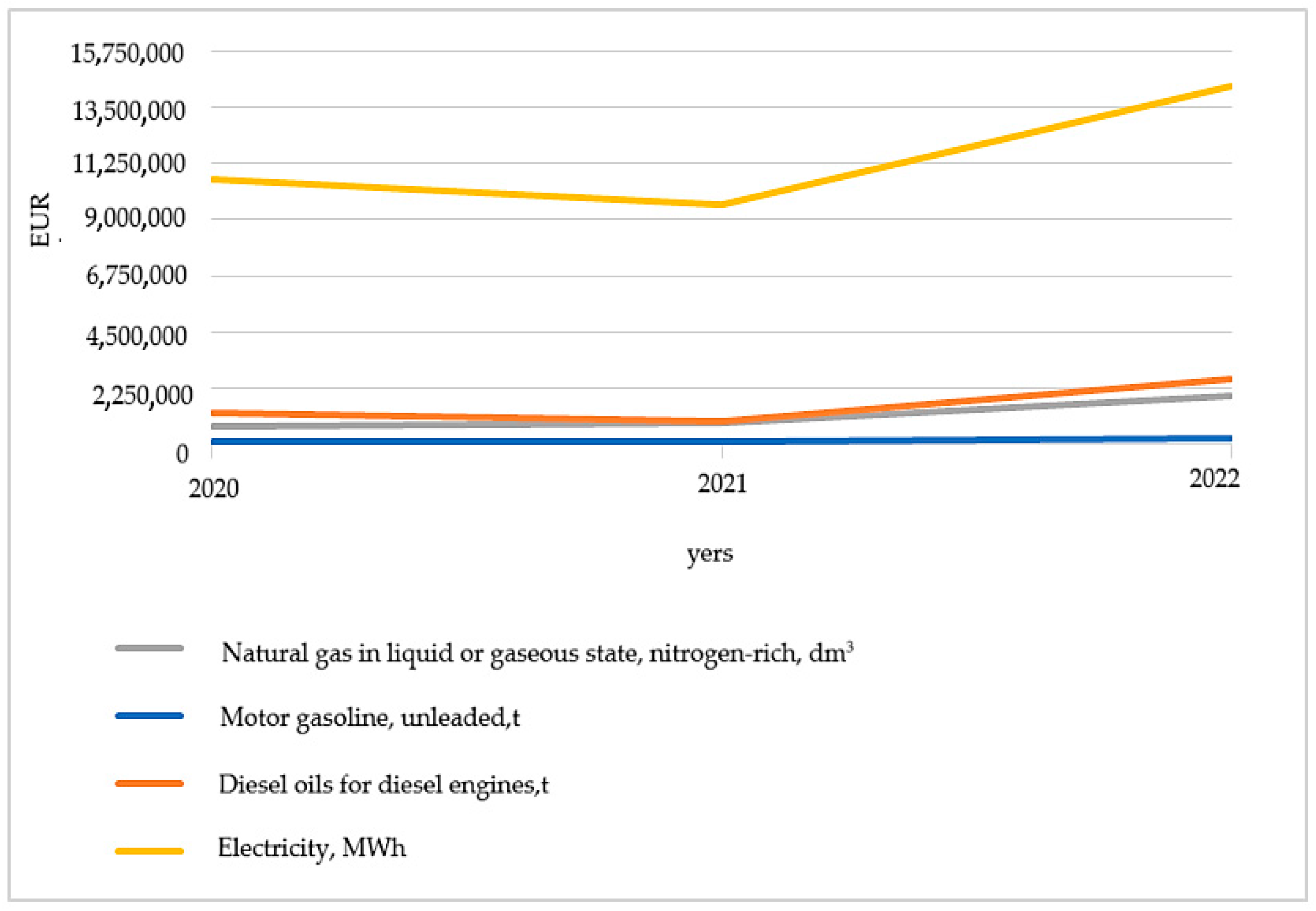
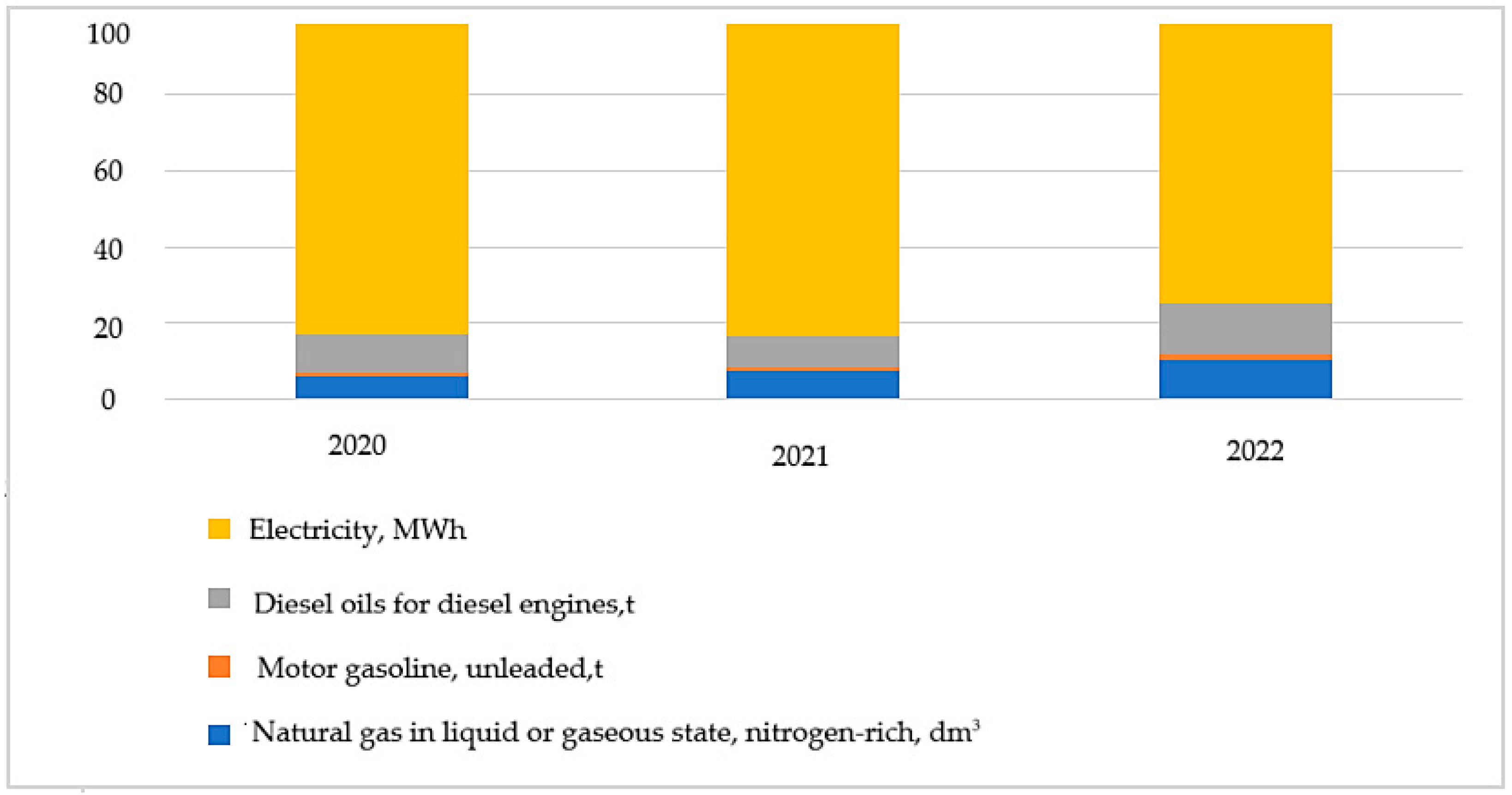
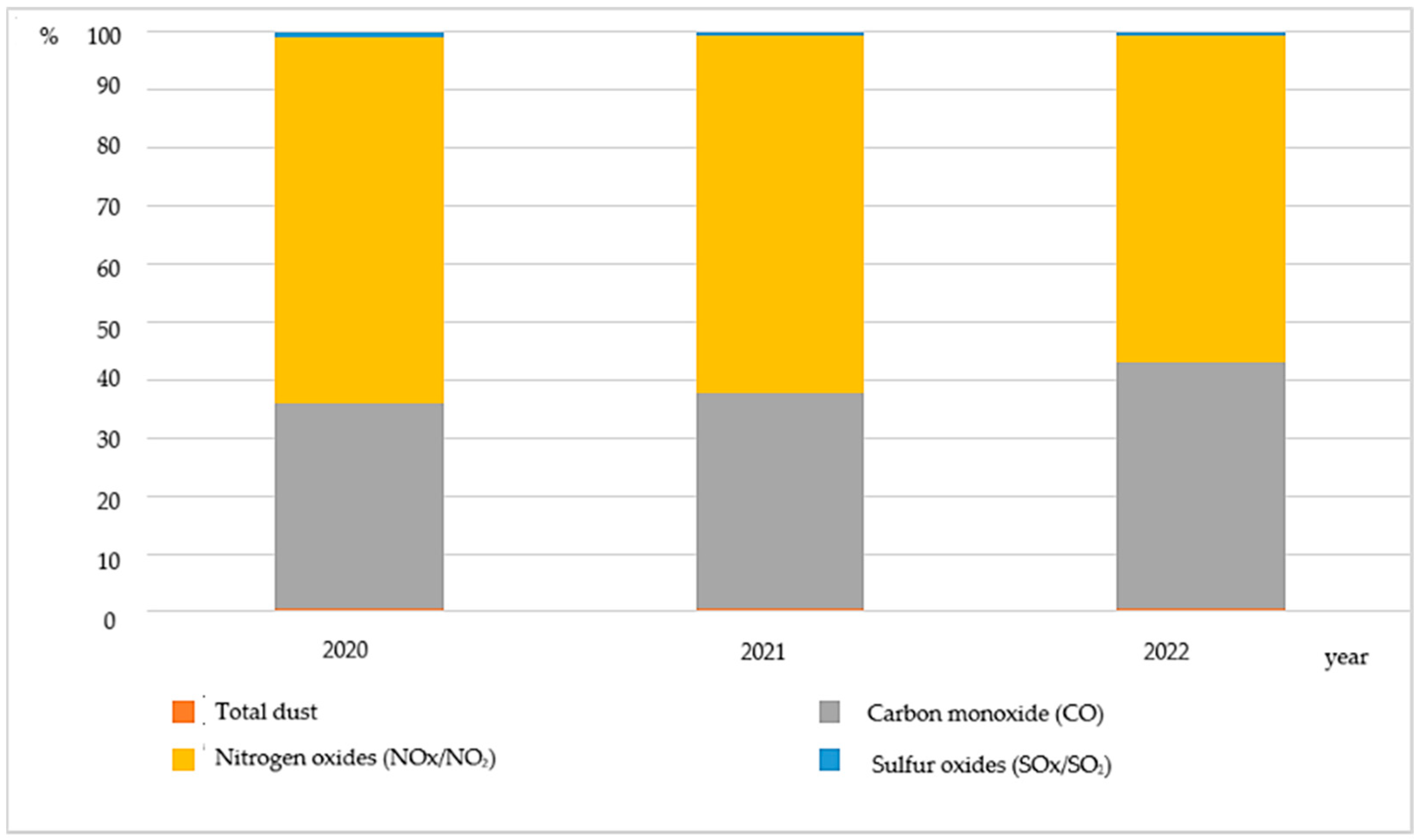

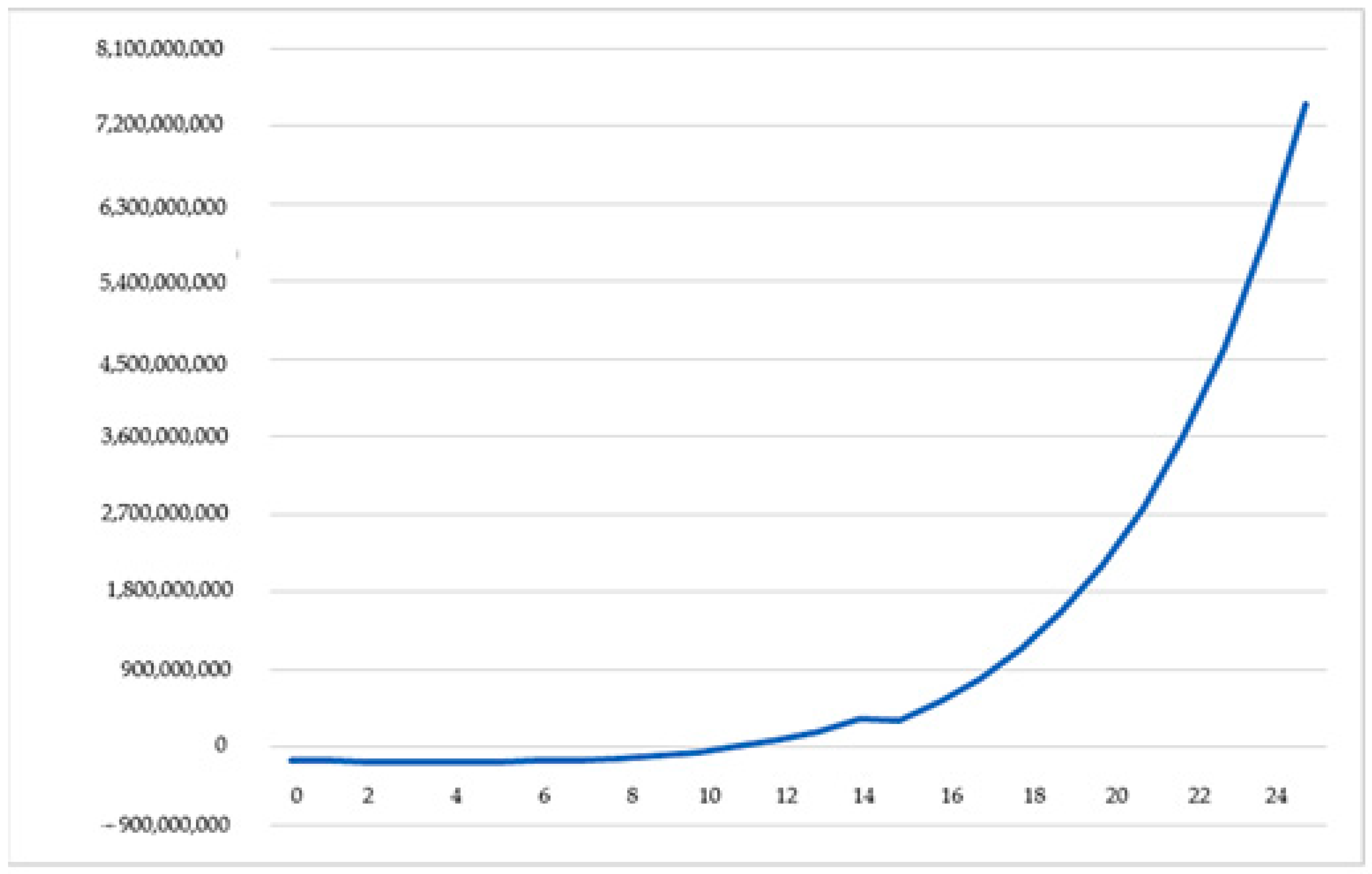
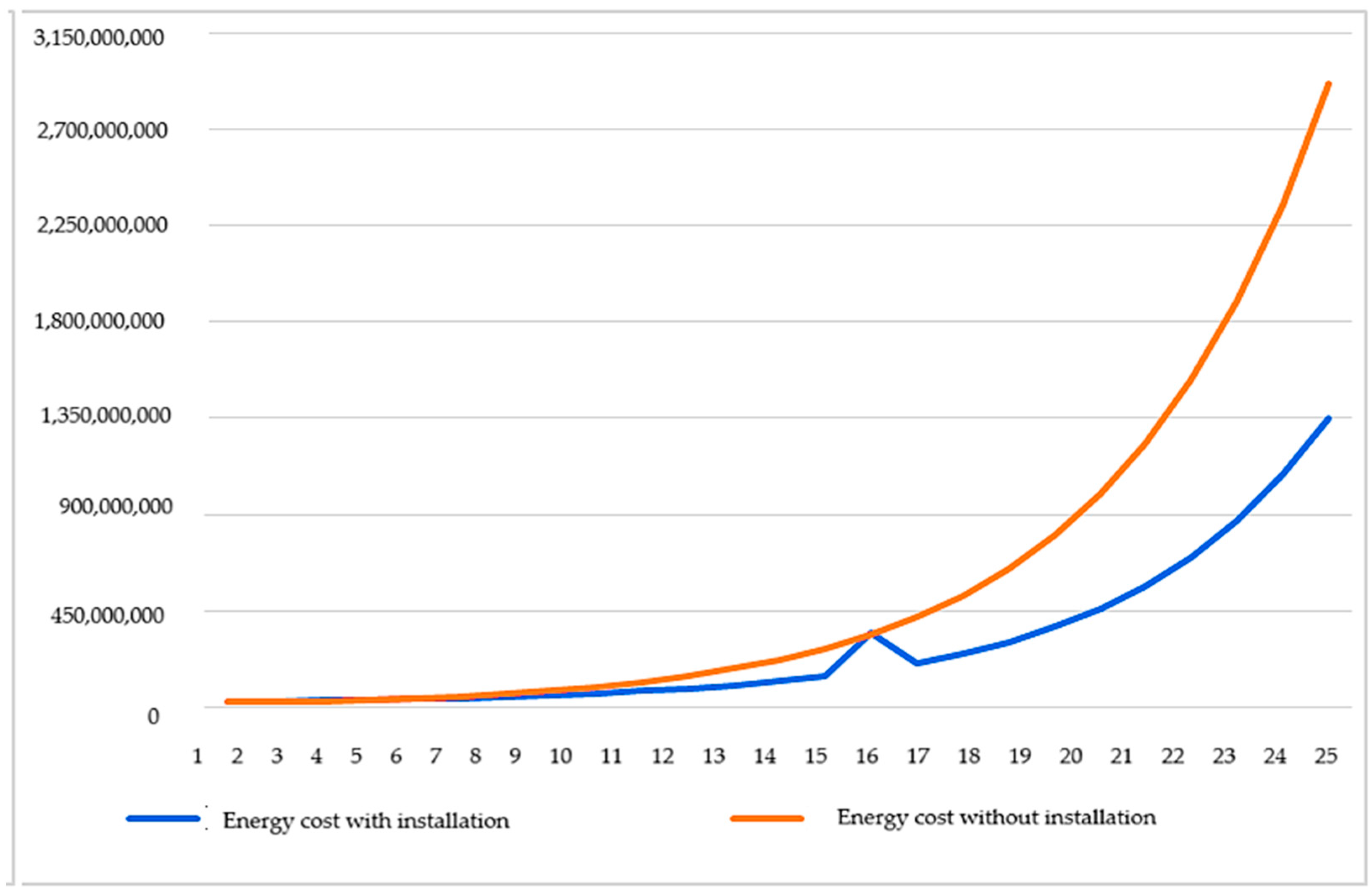
| Name of the Energy Carrier | Total Purchase | ||
|---|---|---|---|
| 2020 | 2021 | 2022 | |
| Natural gas in liquid or gaseous state, nitrogen-rich, [dm3] | 86.3 | 85.1 | 89 |
| Motor gasoline, unleaded, [t] | 5.4 | 5.7 | 6.4 |
| Diesel oils for diesel engines, [t] | 46.7 | 47.2 | 73.7 |
| Electricity, [MWh] | 7959.9 | 6540.6 | 4364.8 |
| Name of the Energy Carrier | Value in EUR (Excluding VAT) | ||
|---|---|---|---|
| 2020 | 2021 | 2022 | |
| Natural gas in liquid or gaseous state, nitrogen-rich, [dm3] | 738,000 | 851,400 | 1935 |
| Motor gasoline, unleaded, [t] | 145,800 | 116,550 | 275,400 |
| Diesel oils for diesel engines, [t] | 1,260,900 | 931.5 | 2,643,750 |
| Electricity, [MWh] | 10,619,550 | 9,624,600 | 14,344,200 |
| Sum | 12,764,250 | 11,524,050 | 19,198,350 |
| Specification | dm3 (Thousand m3/Year) | |
|---|---|---|
| Water taken from the plant’s intakes | underground (from a well) | 1 |
| surface inland | 83 | |
| internal marine waters | 0 | |
| from drainage of mining plants and construction facilities | 0 | |
| Total | 84 | |
| Purchasing water from other entities | 0 | |
| Water consumption for the plant | Total | 84 |
| including for production | 0 | |
| Water sales | 0 | |
| Water losses in the network | 0 | |
| Name of the Energy Carrier | Unit of Measure | Production | Total Purchase | Other Income | Sale | Other Income | Wear | ||
|---|---|---|---|---|---|---|---|---|---|
| Quantity | Value in EUR (Excluding VAT) | Quantity | Value in EUR (Excluding VAT) | Quantity | |||||
| Natural gas in liquid or gaseous state, nitrogen-rich | dm3 | 0 | 382,950 | 851.4 | 0 | 0 | 0 | 0 | 382.95 |
| Motor gasoline, unleaded | t | 0 | 25,650 | 116.5 | 0 | 0 | 0 | 0 | 2565 |
| Diesel oils for engines (diesel) | t | 0 | 212,400 | 931.5 | 0 | 0 | 0 | 0 | 21,240 |
| Electricity | MWh | 0 | 29,432,700 | 9624.6 | 0 | 0 | 0 | 0 | 29,432.70 |
| Heat in steam and hot water | GJ | 7348.5 | 0 | 0 | 0 | 0 | 0 | 0 | 7348.5 |
| Strengths |
|
| Weaknesses |
|
| Chances |
|
| Threats |
|
| Strengths |
|
| Weaknesses |
|
| Chances |
|
| Threats |
|
| Name of the Substance | Emission Volume [kg] | ||
|---|---|---|---|
| 2020 | 2021 | 2022 | |
| Carbon dioxide (Carbon dioxide CO2) | 174,629.430 | 179,328.984 | 189,067.477 |
| Total dust | 1.342 | 1.555 | 1.640 |
| Dust PM10 | 1.337 | 1.555 | 1.640 |
| Dust PM2.5 | 1.337 | 1.555 | 1.640 |
| Benzo(a)piren | 2.438 × 10−6 | 2.489 × 10−6 | 2.624 × 10−6 |
| Carbon monoxide (CO) | 83.302 | 93.320 | 98.387 |
| Nitrogen oxides (NOx/NO2) | 149.263 | 155.533 | 131.183 |
| Sulfur oxides (SOx/SO2) | 1.888 | 1.244 | 1.312 |
| Parameters | Value |
|---|---|
| Installation power, [kWp] | 7875 |
| Annual demand for electricity, [kWh] | 6,300,000 |
| Nominal annual energy yield of the system, [kWh/kWp] | 1039.8 |
| Annual drop in system performance, [%] | 0.7 |
| Investment cost, [EUR] | 153,000,000 |
| Annual operating costs, [EUR] | 22,500,000 |
| Annual drop in system performance | 25 |
| Estimated cost of replacing the inverter in the 15th year of operation, [EUR] | 180,000,000 |
| Level of self-consumption of generated energy, [%] | 40.0 |
| Energy purchase tariff, [EUR/kWh] | 5.40 |
| Unit price of energy consumed from the network, [EUR/kWh] | 3.28 |
| The inflation rate of prices of goods and services on the market, [%] | 8.2 |
| Inflation rate of electricity purchase prices, [%] | 24.0 |
| Rate of return on safe capital investment, [%] | 6.6 |
| Inflation rate of electricity sales prices, [%] | 20.0 |
| Year | Efficiency *, [%] | Installation Power, [kWp] | Energy Yield, [kWh/Year] | Auto Energy Consumption, [kWh] | Energy Sales Price, [EUR/kWh] | Revenue from Energy Sales Less VAT, [EUR] |
| 1 | 100 | 7875.00 | 8,188,425.00 | 3,275,370.00 | 1.800 | 6,809,494.230 |
| 2 | 99.30 | 7819.88 | 8,131,106.03 | 3,252,442.41 | 2.160 | 8,114,193.324 |
| 3 | 98.60 | 7764.75 | 8,073,787.05 | 3,229,514.82 | 2.610 | 9,668,392.286 |
| 4 | 97.90 | 7709.63 | 8,016,468.08 | 3,206,587.23 | 3.105 | 11,519,703.100 |
| 5 | 97.20 | 7654.50 | 7,959,149.10 | 3,183,659.64 | 3.735 | 13,724,802.550 |
| 6 | 96.50 | 7599.38 | 7,901,830.13 | 3,160,732.05 | 4.500 | 16,351,153.660 |
| 7 | 95.80 | 7544.25 | 7,844,511.15 | 3,137,804.46 | 5.355 | 19,479,053.110 |
| 8 | 95.10 | 7489.13 | 7,787,192.18 | 3,114,876.87 | 6.435 | 23,204,066.180 |
| 9 | 94.40 | 7434.00 | 7,729,873.20 | 3,091,949.28 | 7.740 | 27,639,922.370 |
| 10 | 93.70 | 7378.88 | 7,672,554.23 | 3,069,021.69 | 9.270 | 32,921,958.380 |
| 11 | 93.00 | 7323.75 | 7,615,235.25 | 3,046,094.10 | 11.160 | 39,211,211.900 |
| 12 | 92.30 | 7268.63 | 7.557.916,28 | 3,023,166.51 | 13.365 | 46,699,288.520 |
| 13 | 91.60 | 7213.50 | 7,500,597.30 | 3,000,238.92 | 16.065 | 55,614,147.260 |
| 14 | 90.90 | 7158.38 | 7,443,278.33 | 2,977,311.33 | 19.260 | 66,226,977.990 |
| 15 | 90.20 | 7103.25 | 7,385,959.35 | 2,954,383.74 | 23.130 | 78,860,375.100 |
| 16 | 89.50 | 7048.13 | 7,328,640.38 | 2,931,456.15 | 27.720 | 93,898,051.920 |
| 17 | 88.80 | 6993.00 | 7,271,321.40 | 2,908,528.56 | 33.300 | 111,796,384.500 |
| 18 | 88.10 | 6937.88 | 7,214,002.43 | 2,885,600.97 | 39.915 | 133,098,128.100 |
| 19 | 87.40 | 6882.75 | 7,156,683.45 | 2,862,673.38 | 47.925 | 158,448,713.600 |
| 20 | 86.70 | 6827.63 | 7,099,364.48 | 2,839,745.79 | 57.510 | 188,615,608.300 |
| 21 | 86.00 | 6772.50 | 7,042,045.50 | 2,816,818.20 | 69.030 | 224,511,312.300 |
| 22 | 85.30 | 6717.38 | 6,984,726.53 | 2,793,890.61 | 82.800 | 267,220,673.600 |
| 23 | 84.60 | 6662.25 | 6,927,407.55 | 2,770,963.02 | 99.360 | 318,033,326.900 |
| 24 | 83.90 | 6607.13 | 6,870,088.58 | 2,748,035.43 | 119.250 | 378,482,214.500 |
| 25 | 83.20 | 6552.00 | 6,812,769.60 | 2,725,107.84 | 143.100 | 450,389,324.300 |
| Year | Energy Purchase Price, [EUR/kWh] | Energy Purchase Cost, [EUR] | Current Expenses, [EUR] | Energy Cost without Installation, [EUR] | Cash Flow, [EUR] | Cumulative Cash Flow, [EUR] |
| 0 | 153,000,000.0 | −153,000,000.000 | −153,000,000.000 | |||
| 1 | 3.285 | 9,935,909.55 | 22,500,000.00 | 20,695,500.00 | −4,930,915.320 | −157,930,915.300 |
| 2 | 3.285 | 10,011,226.68 | 24,345,000.00 | 20,695,500.00 | −5,546,533.365 | −163,477,448.700 |
| 3 | 4.095 | 12,507,314.31 | 26,341,290.00 | 25,662,420.00 | −3,517,792.065 | −166,995,240.700 |
| 4 | 5.040 | 15,624,877.41 | 28,501,275.78 | 31,821,400.80 | −785,049.255 | −167,780,290.000 |
| 5 | 6.255 | 19,518,449.45 | 30,838,380.39 | 39,458,537.01 | 2,826,509.715 | −164,953,780.300 |
| 6 | 7.785 | 24,380,943.08 | 33,367,127.58 | 48,928,585.86 | 7,531,668.855 | −157,422,111.400 |
| 7 | 9.630 | 30,453,171.03 | 36,103,232.07 | 60,671,446.47 | 13,594,096.530 | −143,828,014.900 |
| 8 | 11.925 | 38,035,726.07 | 39,063,697.07 | 75,232,593.63 | 21,337,236.680 | −122,490,778.200 |
| 9 | 14.805 | 47,503,804.82 | 42,266,920.23 | 93,288,416.09 | 31,157,613.410 | −91,333,164.830 |
| 10 | 18.360 | 59,325,703.61 | 45,732,807.68 | 115,677,636.00 | 43,541,083.040 | −47,792,081.790 |
| 11 | 22.770 | 74,085,894.63 | 49,482,897.93 | 143,440,268.60 | 59,082,687.950 | 11,290,606.160 |
| 12 | 28.215 | 92,513,816.87 | 53,540,495.55 | 177,865,933.10 | 78,510,909.150 | 89,801,515.310 |
| 13 | 35.010 | 115,519,794.20 | 57,930,816.20 | 220,553,757.00 | 102,717,293.900 | 192,518,809.200 |
| 14 | 43.425 | 144,239,844.80 | 62,681,143.14 | 273,486,658.70 | 132,792,648.800 | 325,311,457.900 |
| 15 | 53.820 | 180,091,579.50 | 67,820,996.84 | 339,123,456.80 | −9,928,744.515 | 315,382,713.400 |
| 16 | 66.735 | 224,843,931.90 | 73,382,318.60 | 420,513,086.40 | 216,184,887.800 | 531,567,601.200 |
| 17 | 82.755 | 280,704,138.40 | 79,399,668.74 | 521,436,227.10 | 273,128,804.500 | 804,696,405.700 |
| 18 | 102.645 | 350,426,233.60 | 85,910,441.58 | 646,580,921.60 | 343,342,374.500 | 1,148,038,780.000 |
| 19 | 127.260 | 437,446,376.10 | 92,955,097.76 | 801,760,342.90 | 429,807,582.600 | 1,577,846,363.000 |
| 20 | 157.815 | 546,051,635.90 | 100,577,415.80 | 994,182,825.10 | 536,169,381.800 | 2,114,015,745.000 |
| 21 | 195.660 | 681,590,509.20 | 108,824,763.90 | 1,232,786,703.00 | 666,882,742.400 | 2,780,898,487.000 |
| 22 | 242.640 | 850,735,467.40 | 117,748,394.50 | 1,528,655,512.00 | 827,392,323.600 | 3,608,290,811.000 |
| 23 | 300.870 | 1,061,810,392.0 | 127,403,762.90 | 1,895,532,835.00 | 1,024,352,007.000 | 4,632,642,817.000 |
| 24 | 373.095 | 1,325,198,918.0 | 137,850,871.40 | 2,350,460,715.00 | 1,265,893,140.000 | 5,898,535,958.000 |
| 25 | 462.645 | 1,653,853,658.0 | 149,154,642.90 | 2,914,571,287.00 | 1,561,952,310.000 | 7,460,488,268.000 |
| Name | Size | Criterion |
|---|---|---|
| Net present value, [EUR] | 1,821,234,989.205 | NPV > 0 |
| Internal interest rate, % | 17.57 | IRR > Cost of raising capital |
Disclaimer/Publisher’s Note: The statements, opinions and data contained in all publications are solely those of the individual author(s) and contributor(s) and not of MDPI and/or the editor(s). MDPI and/or the editor(s) disclaim responsibility for any injury to people or property resulting from any ideas, methods, instructions or products referred to in the content. |
© 2024 by the authors. Licensee MDPI, Basel, Switzerland. This article is an open access article distributed under the terms and conditions of the Creative Commons Attribution (CC BY) license (https://creativecommons.org/licenses/by/4.0/).
Share and Cite
Lewicki, W.; Niekurzak, M. Strategic Assessment of the Environmental Impact of Ski Resorts as Part of the Polish Energy Policy Project. Energies 2024, 17, 3166. https://doi.org/10.3390/en17133166
Lewicki W, Niekurzak M. Strategic Assessment of the Environmental Impact of Ski Resorts as Part of the Polish Energy Policy Project. Energies. 2024; 17(13):3166. https://doi.org/10.3390/en17133166
Chicago/Turabian StyleLewicki, Wojciech, and Mariusz Niekurzak. 2024. "Strategic Assessment of the Environmental Impact of Ski Resorts as Part of the Polish Energy Policy Project" Energies 17, no. 13: 3166. https://doi.org/10.3390/en17133166
APA StyleLewicki, W., & Niekurzak, M. (2024). Strategic Assessment of the Environmental Impact of Ski Resorts as Part of the Polish Energy Policy Project. Energies, 17(13), 3166. https://doi.org/10.3390/en17133166






